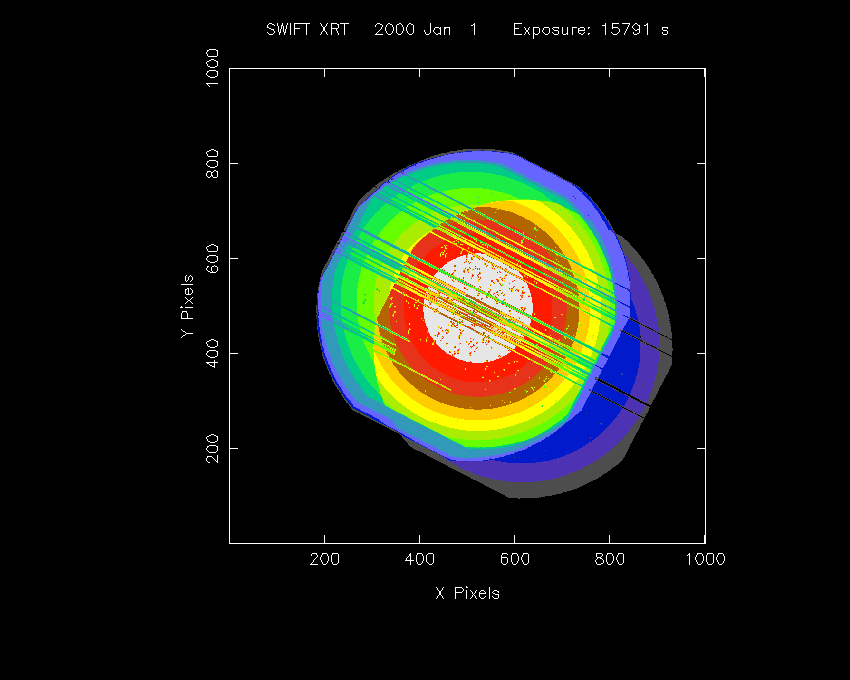- Home
- About
- Support
- Data Access
- Data Analysis
- Data Products
- Publications
-
Links
Databases NED Simbad GCN circulars archive GRB data table Software & Tools Swift Software (HEASoft) Xanadu WebPIMMS Institutional Swift Sites GSFC PSU OAB SSDC MSSL University of Leicester
Building exposure maps
Exposure maps are used to correct for the loss of flux caused by some of the CCD pixels not being used to collect data.
At the end of May 2005, the XRT CCD was hit by a micrometeoroid. This has led to a small number of hot columns in PC and WT modes being vetoed in order to prevent saturation of the telemetry. In the now-discontinued photodiode mode, the CCD would be read out without retaining spatial information, meaning that individual columns cannot be masked out.
The Swift software allows the user to correct for the loss of flux
which occurs when the source is positioned over a hot column. When
running xrtpipeline, an exposure map will be automatically created for
each full eventlist (see
the xrtpipeline thread). They
can also be produced independently, as shown below (using GRB 091029 as an
example):
> xrtexpomap infile=sw00374210000xpcw3po_cl.evt attfile=sw00374210000pat.fits hdfile=sw00374210000xhd.hk outdir=./
where the *pat.fits and *hd.hk can be found in the auxil and xrt/hk directories respectively. (Files can also be used when zipped.) NB The relevant attitude file may actually be *sat.fits or *uat.fits; whichever file was used when creating the *cl.evt file is needed. More details are given on the xrtdigest.
The image above shows an example of a PC exposure map, covering many snapshots of data. Because the pointing of Swift can vary between snapshots, the bad columns etc appear in different sky coordinates each time; this leads to the series of "streaks" across the image. For reference, in detector coordinates these are at DETX = 290-295 in WT mode (291-294 are permanantly vetoed onboard, with the ground software masking out an additional column to either side) and 290-294 (in total) in PC; columns DETX=319-321 are also blanked out in both modes.
Sometimes exposure maps will be required for intervals shorter or longer than one complete observation (where an observation here correponds to a single Observation ID - i.e., the 11 digit number, such as 00374210000 above). These possibilities require two different methods:
-
If the period of interest is shorter than the complete Observation ID
(e.g., a single snapshot), then an
eventlist should be extracted for this time interval
within XSELECT. This eventlist can then be used to
create a corresponding exposure map:
> xrtexpomap infile=orb1.evt attfile=sw00374210000pat.fits.gz hdfile=sw00374210000xhd.hk.gz outdir=./ stemout=orb1
Thestemoutcommand is required whenever the name of the eventlist is not of the form sw[obsid]x<mode><window><type>_cl.evt - If multiple Observation IDs are to be combined, then exposure maps need to be created for each individual Obs ID and then merged; the easiest (though rather slow!) method is to use
XIMAGE. For example:> ximage > read sw[obsid1]xpcw3po_ex.img > read sw[obsid2]xpcw3po_ex.img > sum > save > read sw[obsid3]xpcw3po_ex.img > sum > save > write/fits sum_ex.img
Then, after exitingXIMAGE, the vignetting keyword needs to be added:> fparkey F sum_ex.img+0 VIGNAPP add=yes
These exposure maps are then used to correct the flux: see the ARF thread. xrtlccorr also uses exposure maps for correcting light-curves.

